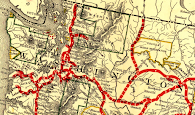[Early History]-[1774-1860]-[Civil War - 1889]-[1890-1913]
[WWI-1938]-[WWII-1974]-[1975-1990]-[1991-2005]-[2006-2030]
[1890-1913] Farms, Lumber, Schools, and more!
1890
A sawmill, shingle mills, and farms dotted the "downtown" Bellevue area.
The growing community now had a school and about 20 families settled in the Clyde Hill, Medina and recently-named downtown Bellevue area.
 |
| 1890 Bellevue City plot for area the be called The Moorlands. placed over modern map. |
1892
2-room Main Street School with a bell tower is built on the S. E. corner of 100th and Main Street.
Adelaide Frances Mickels was teacher.
 |
| Old Main Street Schoolhouse in Bellevue. Ca. 1905. Credit: University of Washington Libraries, Special Collections |
 |
| Map of railroad, government, and school lands in King County, including Northern Pacific RR land sold into private ownership, 1892 (above). |
Mercer Slough/Phantom Lake School opened in an abandoned bachelor’s cabin.
(Around 1911 it was enlarged; closed in 1917 when a new school was built)
||
|||
|
The students had to carry their chairs to school with them and the school term was only four months a year.
|
 |
| Gold prospectors and supplies outside of merchant Cooper & Levy, Seattle, ca. 1897 |
The depression from the Panic of 1893 did not ease until onset of the Klondike Gold Rush in 1897. July 17, 1897, the steamship Portland arrived in Seattle from Alaska with 68 miners and a cargo of “more than a ton of solid gold” from the banks of the Klondike River in Canada's Yukon Territory. This set off a rush to Alaska and an era of prosperity in King County that lasted more than a decade
|
|
1898
Puget Sound Energy's predecessor Puget Sound Power and Light builds the region's first large hydroelectric plant at Snoqualmie Falls.
|
1900
January 3rd, 1900
James J. Hill (1838 – 1916) CEO of Great Northern Railway sold 900,000 acres (originally given to railroad in return for constructing transcontinental Northern Pacific Railway) to German-immigrant Frederick Weyerhaeuser for $6.00/acre

100 persons living on Meydenbauer Bay; 200 persons living in Medina, Hunts Point, Yarrow Point (The Points) and Clyde Hill; 100 persons living in Killarney (approximately Southeast 25th Street of present-day Bellevue).
|
Factoria School opened creating Factoria School District #134.
Weyerhaeuser owned more than 1.5 million acres of land in Washington including some sold off to become part of present-day Bellevue's Lake Hill's neighborhood.
The initial Unincorporated City of Bellevue was originally platted and recorded by Oliver Franz and William Raine
|
|
1905
Early landowners within the limits of Clyde Hill included Jacob Furth, a "Mr. Mercer", and others.
|
1907
William Raine and John Reiner were listed as owners of the property that would later become the Bellevue Bus Transit Center
|
1907-1909
FIRST AUTOMOBILES ON THE EASTSIDE
|
1907 - A lone telephone line reaches Medina.
|
1908
1909
Hunts Point School, a one-room schoolhouse opens. Miss Maude Bechtel was the first teacher. (8 grades in one room) Miss Jepson, Mr. Einer Mr. Fretheim and Rudolph Elmer were principals. By 1917, another room had been added. Through the years, more additions and remodeling were done. Later the school was called Bay School and joined with Medina to be the Bay/Medina School. The school burned down in 1950
|
1910
Population of Bellevue increased to almost 1,500 people.
First Medina School opened as its own little school district #17. The Medina Grocery store is built
1910 Samuel Curtiss Foster (1881-1960) and wife Harriett Elizabeth Woods (1880-1959) filed a "Declaration of Homestead" document and built a cabin on the west side of their 1-acre Yarrow Point property that fronted on 92nd Avenue NE and extended eastward to 94th Avenue NE.
|
1911
The Lake Washington Ship Canal project began in 1911 to accommodate the approximately 20-foot (6.1 m) difference in water level between Lake Washington and Puget Sound
|
1912
Beaux Arts School property was obtained from several different Individuals for the sum of $1,000.00.
The Main Street School was established as a two-year secondary school in District #49;
The entire high school and eighth grade shared a single room in the Main Street School.
Frances Gordon and Norma Morgan were the first graduates.
|
1913
Modern Ferryboats replace Steamers: In December the ferry Leschi was launched and with it came a major change in the transportation system. People could take their motor vehicles with them to Seattle and to the Eastside.
|
In 1913, George F. Meacham deeded two acres for a park that became known as the George F. Meecham-Morningside Park and later the location of the Yarrow Point Town Hall, dedicated in 1990
|
1913 When Ove P. Larsen died, half the Larsen Lake property was sold to 4 Aries brothers, who turned the property into one of the largest vegetable farms in the area. The Aries farm shipped produce as far away as Alaska, the Philippines and Yukon Territory.
Other Larsen land was purchased by J.J. Bryce (Brys).
|















No comments:
Post a Comment